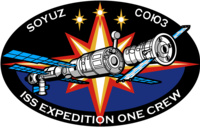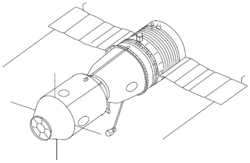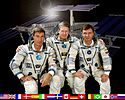Sojuz TM-31
| Sojuz TM-31 (Союз ТM-31) | |||
 | |||
| Beställare | Roskosmos | ||
|---|---|---|---|
| Modell | Sojuz-TM | ||
| Tillverkare | RKK Energia | ||
| Operatör | Roskosmos | ||
| Anrop | Uran | ||
| Färdens tid | 186 dag, 21 tim, 48 min, 41 sek | ||
| NSSDC-ID | 2000-070A[1] | ||
| Uppskjutning | |||
| Startplats | Bajkonur LC1 | ||
| Start | 31 oktober 2000, 07:52:47 UTC | ||
| Raket | Sojuz-U | ||
| Landning | |||
| Landningsplats | ~90 km NÖ om Arkalyk, Kazakstan | ||
| Landning | 6 maj 2001, 05:41:28 UTC | ||
| Omloppsbana | |||
| Varv | 3 040 st[2] | ||
| Apogeum | 249 km | ||
| Perigeum | 190 km | ||
| Banlutning | 51,6° | ||
| Besättning | |||
| Start | Jurij Gidzenko Sergej K. Krikaljov William M. Shepherd | ||
| Landning | Talgat Musabajev Jurij Baturin Dennis Tito | ||
 V-H: Krikaljev, Shepherd, Gidzenko | |||
| Dockning | |||
| Rymdstation | ISS | ||
| Dockning | 2 november 2000, 09:21 UTC | ||
| Port | Zvezda, akter | ||
| Ur dockning | 24 februari 2001, 10:06 UTC | ||
| Andra Dockning | 24 februari 2001, 10:37 UTC | ||
| Port | Zarja, nadir | ||
| Andra ur dockning | 18 april 2001, 12:40 UTC | ||
| Tredje Dockning | 18 april 2001, 13:01 UTC | ||
| Port | Zvezda, akter | ||
| Tredje ur dockning | 6 maj 2001, 02:21 UTC | ||
| Tid dockad | ~183 dagar | ||
| Kronologi | |||
| |||
Sojuz TM-31 (ryska: Союз ТM-31) var en flygning i det ryska rymdprogrammet. Det var den första Sojuz-flygningen till Internationella rymdstationen med den första långtids-besättningen på ISS. Farkosten sköts upp med en Sojuz-U-raket från Kosmodromen i Bajkonur den 31 oktober 2000. Man dockade med rymdstationen den 2 november 2000.
Den 24 februari 2001 flyttades farkosten från akterporten på Zvezda-modulen till nadirporten på Zarja-modulen.
Den 18 april 2001 flyttades farkosten tillbaka till akterporten på Zvezda-modulen.
Efter att ha tillbringat 183 dagar ombord lämnade man rymdstationen. Några timmar senare återinträdde den i jordens atmosfär och landade i Kazakstan.
Källor och referenser
- ^ ”NASA Space Science Data Coordinated Archive” (på engelska). NASA. https://nssdc.gsfc.nasa.gov/nmc/spacecraft/display.action?id=2000-070A. Läst 29 februari 2020.
- ^ Manned Astronautics - Figures & Facts Arkiverad 4 mars 2016 hämtat från the Wayback Machine., läst 9 oktober 2016.
| |||||||||||||||||||||||||||||||||||||||||||||||||||||||||||||||||||||||||||||||||||||||||
| |||||||||||||||||||||||||||||||
| ||||||||||||||||||||||||||||||||
Media som används på denna webbplats
Soyuz-A manned spacecraft concept (1963). It was to have been part of the Soyuz A-B-C circumlunar complex.
Apollo-Soyuz Test Project (ASTP) Soyuz. The APAS-75 docking unit is located at left.
Soyuz-TM spacecraft. Compare the antennas on the orbital module to those on Soyuz-T. Differences reflect the change from the Igla rendezvous system used on Soyuz-T to the Kurs rendezvous system used on Soyuz-TM.
The Soyuz TMA-04M spacecraft is seen after being rolled out by train to the launch pad at the Baikonur Cosmodrome in Kazakhstan, May 13, 2012. The launch of the Soyuz spacecraft, with Expedition 31 Soyuz Commander Gennady Padalka, Flight Engineer Sergei Revin of Russia and NASA Flight Engineer Joe Acaba, is scheduled for 9:01 a.m., May 15 (Kazakhstan time).
Rotated and color enhanced version of original (ISS013-E-48788 (6 July 2006) --- The Space Shuttle Discovery approaches the International Space Station for docking but before the link-up occurred, the orbiter went through a series of inspection photos by station crew to inspect the vehicle for any damage to its Thermal Protection System. This was known as the Rendezvous Pitch Maneuver and was implemented after the Columbia Disaster in 2003. The Leonardo Multipurpose Logistics Module can be seen in the shuttle's cargo bay. Discovery docked at the station's Pressurized Mating Adapter 2 at 9:52 a.m. CDT, July 6, 2006.)
Backdropped by a blue and white Earth, this close-up view features the Soyuz TMA-6 spacecraft approaching the International Space Station (ISS). Onboard the spacecraft are cosmonaut Sergei K. Krikalev, Expedition 11 commander representing Russia's Federal Space Agency; astronaut John L. Phillips, NASA ISS science officer and flight engineer; and European Space Agency (ESA) astronaut Roberto Vittori of Italy. The Soyuz linked to the Pirs Docking Compartment at 9:20 p.m. (CDT) on April 16, 2005 as the two spacecraft flew over eastern Asia. The docking followed Friday’s launch from the Baikonur Cosmodrome in Kazakhstan.
In this illustration, a SpaceX Crew Dragon spacecraft approaches the International Space Station for docking. NASA is partnering with Boeing and SpaceX to build a new generation of human-rated spacecraft capable of taking astronauts to the station and expanding research opportunities in orbit. SpaceX's upcoming Demo-1 flight test is part of NASA’s Commercial Crew Transportation Capability contract with the goal of returning human spaceflight launch capabilities to the United States.
Författare/Upphovsman: Pascal (Flickr user: pasukaru76), Licens: CC0
Vostok spacecraft replica at the Technik Museum Speyer, Germany.
Crew of ISS Expedition 1 launched with Soyuz TM-31
ISS Expedition One Commander William M. (Bill) Shepherd (center) is flanked by Soyuz Commander Yuri P. Gidzenko (right) and Flight Engineer Sergei K. Krikalev (left) in this crew photograph, taken during a break in training in Russia. The three, posed in front of a rendition of the International Space Station, are wearing the Sokol space suits like those they will don for their Soyuz-provided trip to ISS later this month. National flags representing all the international partners run along the bottom of the portrait.




















